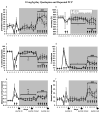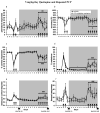Increased impulsivity and disrupted attention induced by repeated phencyclidine are not attenuated by chronic quetiapine treatment
- PMID: 18809428
- PMCID: PMC2747377
- DOI: 10.1016/j.pbb.2008.08.025
Increased impulsivity and disrupted attention induced by repeated phencyclidine are not attenuated by chronic quetiapine treatment
Abstract
Atypical antipsychotic medications differ in how effectively they attenuate cognitive and other deficits in schizophrenia. The present study aimed to explore whether quetiapine, an atypical antipsychotic medication, would reverse disruptions of performance in the 5-choice serial reaction time task (5-CSRTT), a test of attention and impulsivity, induced by repeated administration of the psychotomimetic phencyclidine (PCP). In confirmation of previous findings, repeated PCP administration (2 mg/kg, s.c., 30 min before behavioral testing, for 2 consecutive days, followed by a 2-week PCP-free period and then 5 consecutive days of PCP treatment) increased premature responding (impulsivity), decreased accuracy (attention), and increased response latencies (processing speed) and timeout responding (impulsivity/cognitive inflexibility). Chronic quetiapine (5 or 10 mg/kg/day, s.c.) did not attenuate these PCP-induced disruptions in performance, while at the highest dose used, quetiapine disrupted 5-CSRTT performance in the absence of PCP treatment and tended to exacerbate the PCP-induced increase in premature responding. Considering that clozapine, another atypical antipsychotic, was shown previously to reverse PCP-induced deficits in the same task [Amitai N, Semenova S, Markou A. Cognitive-disruptive effects of the psychotomimetic phencyclidine and attenuation by atypical antipsychotic medications in rats. Psychopharmacology (Berl) 2007;193:521-37], the present findings demonstrate differences between clozapine and quetiapine in their effectiveness on schizophrenia-like cognitive deficits and impulsivity that may be attributable to their different receptor affinity profiles.
Figures



References
-
- Abdul-Monim Z, Neill JC, Reynolds GP. Sub-chronic psychotomimetic phencyclidine induces deficits in reversal learning and alterations in parvalbumin-immunoreactive expression in the rat. J Psychopharmacol. 2007;21:198–205. - PubMed
-
- Abdul-Monim Z, Reynolds GP, Neill JC. The atypical antipsychotic ziprasidone, but not haloperidol, improves phencyclidine-induced cognitive deficits in a reversal learning task in the rat. J Psychopharmacol. 2003;17:57–66. - PubMed
-
- Abdul-Monim Z, Reynolds GP, Neill JC. The effect of atypical and classical antipsychotics on sub-chronic PCP-induced cognitive deficits in a reversal-learning paradigm. Behav Brain Res. 2006;169:263–73. - PubMed
-
- Akhtar M, Uma Devi P, Ali A, Pillai KK, Vohora D. Antipsychotic-like profile of thioperamide, a selective H3-receptor antagonist in mice. Fundam Clin Pharmacol. 2006;20:373–8. - PubMed
-
- Allen RM, Young SJ. Phencyclidine-induced psychosis. Am J Psychiatry. 1978;135:1081–4. - PubMed
Publication types
MeSH terms
Substances
Grants and funding
LinkOut - more resources
Full Text Sources

